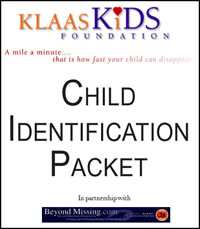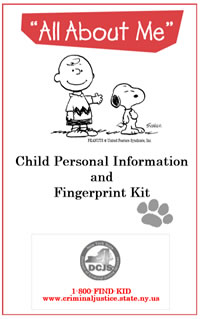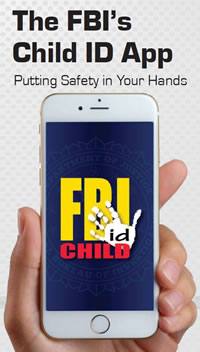
You're here: MibSAR :: M-P Sourcebook Table of Contents :: ID Kits
Proactive SAR —
Child & Adult ID Kits
| << Prior Chapter | Next Chapter >> |
Quickly reporting a missing person to the authorities — especially a child or young adult — is often critical to the outcome of an investigation.
To expedite this process, consider keeping the child or young adult's personal information on-hand, using one of the forms below, just in case. Update the form and photographs periodically.
In addition, collecting and retaining the following physical exemplars is critical:
- DNA: Wearing a pair of sterile gloves (unused, and untouched on the outside), swab the inner cheek of the subject's mouth with a sterile, cotton-tipped swab until it is visibly moist; place the swab in a clean coffee cup or glass and allow it to air-dry for at least 24 hours, until it is absolutely dry (if it is not completely dry, it will eventually mold, which is destructive to the DNA); place the dry swab in a sterile, freezer-grade, zip-lock plastic bag; seal the zip-lock closure with very sticky tape, and then secure the taped closure with staples; label the zip-lock with an indelible marker, clearly noting subject's name, date and time of collection, and name of collecting individual; and secure this zip-lock in another zip-lock and then store it in a freezer until needed.
After the fact, a known DNA profile can be created from relatives of the missing person, and sometimes from:
- personal effects used or handled exclusively by him or her — that no one else has touched — such as a toothbrush, hairbrush, comb, razor, unwashed clothing, etc.;
- retained teeth;
- newborn screening card;
- and biological specimens preserved after blood work or surgery at a doctor's office, medical clinic or hospital facility.
- Fingerprints: Print-out one of the forms below and take it, along with the subject, to a law enforcement agency and they should be willing, perhaps for a small charge, to fingerprint the subject. If they have thick, durable fingerprint cards on-hand, use one of those instead of the less durable printer paper.
Label the fingerprint card with an indelible marker, clearly noting subject's name, date and time of recording, and name of recording individual; and secure the fingerprint card in a manila evelope, labeled as above, and retain it along with the subject's other personal information.
- Scent: For scent-specific K-9 searches — where a K-9 follows the scent of the missing subject and no one else's — it is essential that the K-9 handler have a sample of the subject's scent, one that is not contaminated with anyone else's scent.
Wearing a pair of sterile gloves (unused, and untouched on the outside), take a sterile first-aid gauze pad and wipe it repeatedly along the dry skin on the torso, just below the armpit; repeat this process with a second gauze pad on the torso below the other armpit; place both gauze pads in a clean glass jar with a tight-fitting lid (if the gauze is not completely dry, it may eventually mold, which may be destructive to the scent); seal the cap and jar junction with sticky tape; label the jar with an indelible marker, clearly noting subject's name, date and time of collection, and name of collecting individual; and secure this glass jar in a freezer-grade, zip-lock plastic bag and then store it in a freezer until needed.
Page contents:
Child Identification Packet, by the Klass Kids Foundation, 1994, 4 pages.
All About Me: Child Personal Information and Fingerprint Kit, by the New York State Division of Criminal Justice Services, Missing and Exploited Children Clearinghouse, 2002, 12 pages.
Just the Facts, Just in Case, by the New York State Division of Criminal Justice Services, Missing and Exploited Children Clearinghouse, 2004, 6 pages.
- Missing: A Guide for Families and Friends of Individuals with a Mental Illness Who Have Gone Missing, by Christine Lafond, Stephanie Scherbain & Gita Sud, Mental Health Education Resource Centre of Manitoba, Canada, 2006, 36 pages.
- FBI Child App — Putting Safety in Your Hands, by the Federal Bureau of Investigation (FBI), U.S. Department of Justice
 |
|
| Child Identification Packet, by the Klass Kids Foundation | |
Contents:
- Safety tips for kids
- What to do if your child is missing
- Safety tips for parents
- Photo records
- Identification data
- Fingerprint record
- Safety on the information highway
- Do-it-yourself DNA collection kit
 |
|
| All About Me: Child Personal Information and Fingerprint Kit, by the New York State Division of Criminal Justice Services, Missing and Exploited Children Clearinghouse | |
Contents:
- Emergency telephone info
- A message about safety
- How to use this kit
- Safety tips for you and your children
- Information about you, the parent
- Information about your child
- Photographic records
- Fingerprint records
 |
|
| Just the Facts, Just in Case, by the New York State Division of Criminal Justice Services, Missing and Exploited Children Clearinghouse | |
Contents:
- How to use this booklet
- Facts about subject
- Photo-graphic records
- Finger-print records
- DNA sample
- Scent article
- Note to parents of college students
- Authorization to publicize
 |
|
| Missing: A Guide for Families and Friends of Individuals with a Mental Illness Who Have Gone Missing, by Christine Lafond, Stephanie Scherbain & Gita Sud, Mental Health Education Resource Centre of Manitoba |
Read page 32 for more information on actions to take before a loved one goes missing.
 |
|
FBI Child App — Putting Safety in Your Hands, by the Federal Bureau of Investigation (FBI), U.S. Department of Justice |
FBI Child App — Putting Safety in Your Hands, by the Federal Bureau of Investigation (FBI), U.S. Department of Justice.
Available for both iPhones and Android phones.
| << Prior Chapter | Next Chapter >> |
People who say it cannot be done,
should not interrupt those who are doing it.
— Author unknown

If you've been able to read this
Web page...
thank a Teacher;
If you've been able to read this
Web page in English...
thank a Veteran.
— Author unknown
Copyright © 1984-
October 5, 2023
by Michael A. Neiger
Contact Michael Neiger via e-mail at mneiger@hotmail.com
Top
You're here: MibSAR :: M-P Sourcebook Table of Contents :: ID Kits